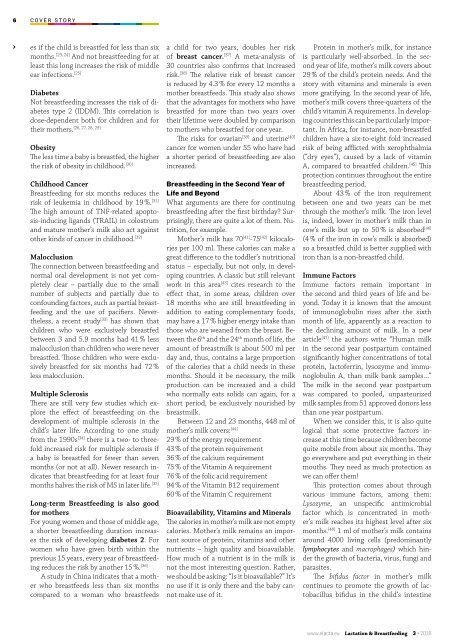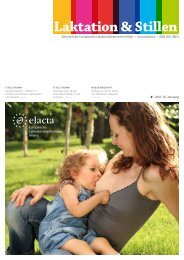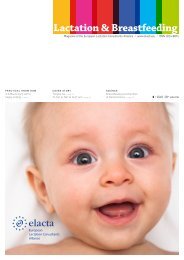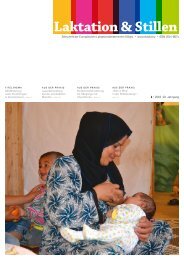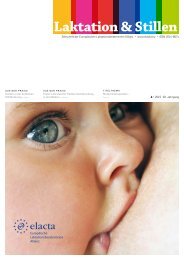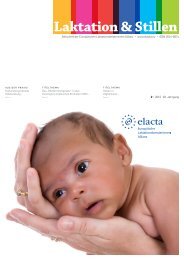Laktation_und_Stillen_2016-3 EN Web p1-10
You also want an ePaper? Increase the reach of your titles
YUMPU automatically turns print PDFs into web optimized ePapers that Google loves.
6<br />
COVER STORY<br />
› es if the child is breastfed for less than six<br />
months. [23, 24] And not breastfeeding for at<br />
least this long increases the risk of middle<br />
ear infections. [25]<br />
Diabetes<br />
Not breastfeeding increases the risk of diabetes<br />
type 2 (IDDM). This correlation is<br />
dose-dependent both for children and for<br />
[26, 27, 28, 29]<br />
their mothers.<br />
Obesity<br />
The less time a baby is breastfed, the higher<br />
the risk of obesity in childhood. [30]<br />
Childhood Cancer<br />
Breastfeeding for six months reduces the<br />
risk of leukemia in childhood by 19 %. [31]<br />
The high amount of TNF-related apoptosis-inducing<br />
ligands (TRAIL) in colostrum<br />
and mature mother’s milk also act against<br />
other kinds of cancer in childhood. [32]<br />
Malocclusion<br />
The connection between breastfeeding and<br />
normal oral development is not yet completely<br />
clear – partially due to the small<br />
number of subjects and partially due to<br />
confo<strong>und</strong>ing factors, such as partial breastfeeding<br />
and the use of pacifiers. Nevertheless,<br />
a recent study [33] has shown that<br />
children who were exclusively breastfed<br />
between 3 and 5.9 months had 41 % less<br />
malocclusion than children who were never<br />
breastfed. Those children who were exclusively<br />
breastfed for six months had 72 %<br />
less malocclusion.<br />
Multiple Sclerosis<br />
There are still very few studies which explore<br />
the effect of breastfeeding on the<br />
development of multiple sclerosis in the<br />
child’s later life. According to one study<br />
from the 1990s [34] there is a two- to threefold<br />
increased risk for multiple sclerosis if<br />
a baby is breastfed for fewer than seven<br />
months (or not at all). Newer research indicates<br />
that breastfeeding for at least four<br />
months halves the risk of MS in later life. [35]<br />
Long-term Breastfeeding is also good<br />
for mothers<br />
For young women and those of middle age,<br />
a shorter breastfeeding duration increases<br />
the risk of developing diabetes 2. For<br />
women who have given birth within the<br />
previous 15 years, every year of breastfeeding<br />
reduces the risk by another 15 %. [36]<br />
A study in China indicates that a mother<br />
who breastfeeds less than six months<br />
compared to a woman who breastfeeds<br />
a child for two years, doubles her risk<br />
of breast cancer. [37] A meta-analysis of<br />
30 countries also confirms that increased<br />
risk. [38] The relative risk of breast cancer<br />
is reduced by 4.3 % for every 12 months a<br />
mother breastfeeds. This study also shows<br />
that the advantages for mothers who have<br />
breastfed for more than two years over<br />
their lifetime were doubled by comparison<br />
to mothers who breastfed for one year.<br />
The risks for ovarian [39] and uterine [40]<br />
cancer for women <strong>und</strong>er 55 who have had<br />
a shorter period of breastfeeding are also<br />
increased.<br />
Breastfeeding in the Second Year of<br />
Life and Beyond<br />
What arguments are there for continuing<br />
breastfeeding after the first birthday? Surprisingly,<br />
there are quite a lot of them. Nutrition,<br />
for example.<br />
Mother’s milk has 70 [41] -75 [42] kilocalories<br />
per <strong>10</strong>0 ml. These calories can make a<br />
great difference to the toddler’s nutritional<br />
status – especially, but not only, in developing<br />
countries. A classic but still relevant<br />
work in this area [43] cites research to the<br />
effect that, in some areas, children over<br />
18 months who are still breastfeeding in<br />
addition to eating complementary foods,<br />
may have a 17 % higher energy intake than<br />
those who are weaned from the breast. Between<br />
the 6 th and the 24 th month of life, the<br />
amount of breastmilk is about 500 ml per<br />
day and, thus, contains a large proportion<br />
of the calories that a child needs in these<br />
months. Should it be necessary, the milk<br />
production can be increased and a child<br />
who normally eats solids can again, for a<br />
short period, be exclusively nourished by<br />
breastmilk.<br />
Between 12 and 23 months, 448 ml of<br />
mother’s milk covers: [44]<br />
29 % of the energy requirement<br />
43 % of the protein requirement<br />
36 % of the calcium requirement<br />
75 % of the Vitamin A requirement<br />
76 % of the folic acid requirement<br />
94 % of the Vitamin B12 requirement<br />
60 % of the Vitamin C requirement<br />
Bioavailability, Vitamins and Minerals<br />
The calories in mother’s milk are not empty<br />
calories. Mother’s milk remains an important<br />
source of protein, vitamins and other<br />
nutrients – high quality and bioavailable.<br />
How much of a nutrient is in the milk is<br />
not the most interesting question. Rather,<br />
we should be asking: “Is it bioavailable?” It’s<br />
no use if it is only there and the baby cannot<br />
make use of it.<br />
Protein in mother’s milk, for instance<br />
is particularly well-absorbed. In the second<br />
year of life, mother’s milk covers about<br />
29 % of the child’s protein needs. And the<br />
story with vitamins and minerals is even<br />
more gratifying. In the second year of life,<br />
mother’s milk covers three-quarters of the<br />
child’s vitamin A requirements. In developing<br />
countries this can be particularly important.<br />
In Africa, for instance, non-breastfed<br />
children have a six-to-eight fold increased<br />
risk of being afflicted with xerophthalmia<br />
(“dry eyes”), caused by a lack of vitamin<br />
A, compared to breastfed children. [45] This<br />
protection continues throughout the entire<br />
breastfeeding period.<br />
About 43 % of the iron requirement<br />
between one and two years can be met<br />
through the mother’s milk. The iron level<br />
is, indeed, lower in mother’s milk than in<br />
cow’s milk but up to 50 % is absorbed [46]<br />
(4 % of the iron in cow’s milk is absorbed)<br />
so a breastfed child is better supplied with<br />
iron than is a non-breastfed child.<br />
Immune Factors<br />
Immune factors remain important in<br />
the second and third years of life and beyond.<br />
Today it is known that the amount<br />
of immunoglobulin rises after the sixth<br />
month of life, apparently as a reaction to<br />
the declining amount of milk. In a new<br />
article [47] the authors write “Human milk<br />
in the second year postpartum contained<br />
significantly higher concentrations of total<br />
protein, lactoferrin, lysozyme and immunoglobulin<br />
A, than milk bank samples…”<br />
The milk in the second year postpartum<br />
was compared to pooled, unpasteurized<br />
milk samples from 51 approved donors less<br />
than one year postpartum.<br />
When we consider this, it is also quite<br />
logical that some protective factors increase<br />
at this time because children become<br />
quite mobile from about six months. They<br />
go everywhere and put everything in their<br />
mouths. They need as much protection as<br />
we can offer them!<br />
This protection comes about through<br />
various immune factors, among them:<br />
Lysozyme, an unspecific antimicrobial<br />
factor which is concentrated in mother’s<br />
milk reaches its highest level after six<br />
months. [48] 1 ml of mother’s milk contains<br />
aro<strong>und</strong> 4000 living cells (predominantly<br />
lymphocytes and macrophages) which hinder<br />
the growth of bacteria, virus, fungi and<br />
parasites.<br />
The bifidus factor in mother’s milk<br />
continues to promote the growth of lactobacillus<br />
bifidus in the child’s intestine<br />
www.elacta.eu Lactation & Breastfeeding 3 • <strong>2016</strong>


